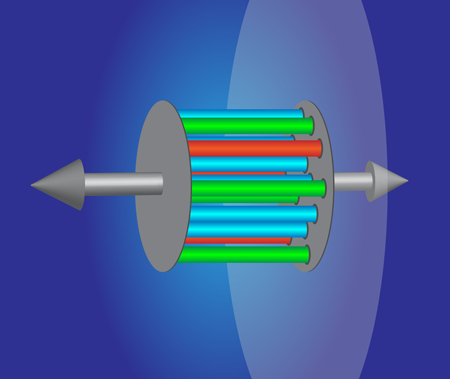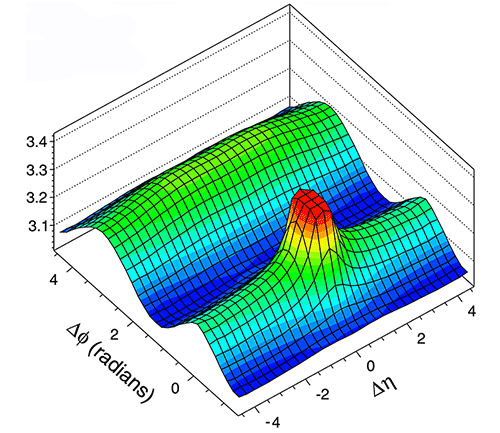The Littlest Liquid
At the world’s most powerful particle accelerators, physicists collide high-energy heavy nuclei to create a soup of particles known as quark-gluon plasma (QGP). This state of matter doesn’t (as was initially expected) behave like a gas of quarks and gluons, but rather like a continuous liquid that, at four trillion degrees Celsius, is the hottest liquid ever created in the lab. So far, researchers have largely focused on plasma produced from collisions between large nuclei, such as gold and lead, each of which contains hundreds of protons and neutrons. Now, experiments from the Compact Muon Solenoid (CMS) Collaboration at CERN’s Large Hadron Collider provide new evidence that the liquidlike state can, unexpectedly, be created from a much smaller number of particles [1]. The researchers studied collisions between a lead nucleus and a single proton and analyzed correlations between particles in the resulting plasma to provide evidence for liquid behavior [1]. In addition to being the hottest and littlest liquid created in the lab, this state of matter is of interest because it carries the imprint of the two projectiles’ quantum states right before the collision.
The liquid that forms from the collision of two heavy nuclei is an “emergent” state, meaning it exhibits properties that cannot be simply extrapolated from the behavior of a few particles [2]. Rather, the plasma’s behavior is quantitatively and qualitatively different than its individual components (quarks and gluons). This behavior results from the strong interactions between particles and is characterized by collective effects, in which each particle’s motion is correlated with that of the others. Such emergent phenomena are common in macroscopic systems, such as superconductivity in metals. Unlike solids, however, which contain of order 1023 atoms, QGP consists of only a few hundred to a few thousand elementary particles.
At CERN, a typical collision between two lead nuclei creates up to 25000 subatomic particles. In contrast, a collision between a proton and a lead nucleus may produce only 1000 particles because the proton impacts just a small volume of the lead nucleus. Researchers did not expect that a liquid would be created from such a small region of impact, and instead assumed that the resulting matter could be described in terms of elementary particle interactions. For this reason, preliminary evidence [3–5] in 2013 that proton-lead collisions had produced a liquid triggered vivid discussions within the high-energy physics community.
The CMS researchers establish liquidlike behavior in the matter formed by a proton-lead nucleus collision by looking for a phenomenon called anisotropic flow, in which the number of particles emerging from the collision varies with azimuthal angle (the angle that winds around the line of collision). This anisotropy results from small density variations in the projectiles at the moment of collision. As shown in Fig. 1, relativistic effects contract the proton and the lead nucleus along their lines of travel, making them appear, in the lab frame, as extremely flat disks. The flattening makes the projectiles essentially homogeneous along the line of collision. In contrast, the density distribution isn’t perfectly smooth in the transverse direction, as the positions of the lead nuclei’s 208 protons and neutrons, which are quantum objects, constantly fluctuate. These initial density variations push on nearby particles, and in a strongly coupled liquid such as the QGP, produce pressure waves (akin to sound waves) that result in anisotropic flow. This effect is analogous to the formation of structure in the early Universe, in which the expanding Universe amplified tiny density fluctuations, resulting in the structures we observe today.
To detect anisotropic flow, the CMS researchers perform what is called a particle correlation analysis. In a two-particle correlation, for example, one looks at all possible pairs of particles and counts the number of pairs as a function of the relative azimuthal angle and longitudinal separation. This counting is then averaged over many collisions. In an earlier study [3,7], the CMS Collaboration measured these two-particle correlations and found, as a function of the relative azimuthal angle, a wave pattern that is characteristic of a liquidlike QGP (see Fig. 2).
The breakthrough in the CMS team’s new work is that they were able to measure the much smaller correlations between six and eight particles. Compared to pairwise correlations, these multiparticle correlations provide more information about the collective liquid state. Over a period of two months in 2013, the authors recorded 50 billion proton-nucleus collisions, but analyzed only the 0.1% most violent ones; namely those producing the largest number of particles, which are more likely to exhibit emergent phenomena. The signals from six- and eight-particle correlations are tiny—they correspond to anisotropies between 10-8 and 10-6—but the CMS Collaboration was able to measure them accurately.
Although other effects can give rise to the anisotropic flow measured by the CMS Collaboration, the simplest explanation is that it arises from quantum fluctuations in the initial projectiles that are enhanced by the formation of a liquidlike QGP. If the fluid interpretation is correct, then the size of the anisotropies the CMS Collaboration has obtained tells us that the initial quantum fluctuations are large. On some level, this is to be expected since small systems like nuclei have large quantum fluctuations. But the new work provides a better estimate of the size of these fluctuations.
Overall, the research from the CMS team contributes to a new perspective on high-energy physics, which has traditionally focused on rare events and the discovery of new elementary particles, rather than the “bulk” of particles produced in a collision. The next step will be to determine to what extent a continuous description provides the best quantitative description of the evolution of such a small system.
This research is published in Physical Review Letters.
References
- V. Khachatryan et al. (CMS Collaboration), “Evidence for Collective Multiparticle Correlations in p−Pb Collisions,” Phys. Rev. Lett. 115, 012301 (2015)
- P. Anderson, “More is Different,” Science 177, 393 (1972)
- CMS Collaboration, “Observation of long-range, near-side angular correlations in p-Pb collisions at the LHC,” Phys. Lett. B 718, 795 (2013) .
- ALICE Collaboration, ”Long-range angular correlations on the near and away side in p-Pb collisions at √sNN=5.02 TeV,” Phys. Lett. B 719,29 (2013)
- ATLAS Collaboration, ”Observation of Associated Near-Side and Away-Side Long-Range Correlations in √sNN=5.02 TeV Proton-Lead Collisions with the ATLAS Detector,” Phys. Rev. Lett. 110, 182302 (2013)
- F. Gelis, E. Iancu, J. Jalilian-Marian, and R. Venugopalan, ”The Color Glass Condensate,” Ann. Rev. Nucl. Particle Science 60, 463 (2010)
- CMS Collaboration, ”Multiplicity and transverse momentum dependence of two- and four-particle correlations in pPb and PbPb collisions,” Phys. Lett. B 724,213 (2013)







